
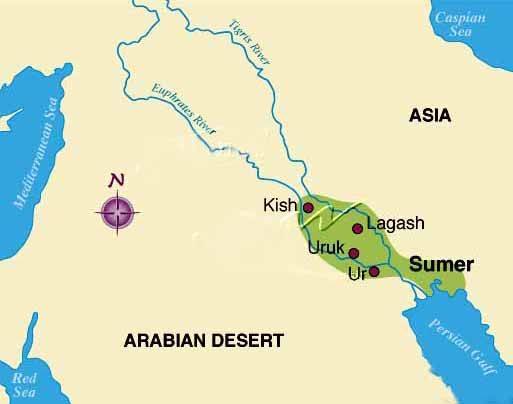
Sumer means "Land of the Lords of the Sun" ... "Land of the Lords of Brightness"


Sumer means "Land of the Lords of the Sun" ... "Land of the Lords of Brightness"
Sumer is the earliest known civilization in the historical region of southern Mesopotamia (south-central Iraq), emerging during the Chalcolithic and early Bronze Ages between the sixth and fifth millennium BC. It is also one of the first civilizations in the world, along with ancient Egypt, the Caral-Supe civilization, the Indus Valley civilization, the Minoan civilization, and ancient China.
Living along the valleys of the Tigris and Euphrates, Sumerian farmers grew an abundance of grain and other crops, the surplus from which enabled them to form urban settlements. Proto-writing dates back before 3000 BC. The earliest texts come from the cities of Uruk and Jemdet Nasr, and date to between c. 3500 and c. 3000 BC.
Evidence of wheeled vehicles appeared in the mid 4th millennium BCE, near-simultaneously in Mesopotamia, the Northern Caucasus (Maykop culture) and Central Europe. The wheel initially took the form of the potter's wheel. The new concept quickly led to wheeled vehicles and mill wheels.
The Sumerians' cuneiform writing system is the oldest that has been deciphered. The status of older inscriptions such as the Vinca signs and the even older Jiahu symbols is controversial.
The Vinca symbols, script, or Old European script, are a set of symbols found on Neolithic era (6th to 5th millennia BCE) artifacts from the Vinca culture of southeastern Europe. The symbols are mostly considered as constituting an instance of "proto-writing"; that is, they probably conveyed a message but did not encode language, predating the development of writing proper by more than a millennium.
Jiahu symbols refer to the 16 distinct markings on prehistoric artifacts found in Jiahu, a neolithic Peiligang culture site found in Henan, China, and excavated in 1999. The Jiahu site dates to 6600 BC; some archaeologists believe the markings to be similar (although without necessarily having the same meaning) to some characters used in a much later writing system related to the oracle bone script, but there is currently no consensus. A 2003 report in Archaeology interpreted them "not as writing itself, but as features of a lengthy period of sign-use which led eventually to a fully-fledged system of writing." The earliest evidence for a corpus of writing in the oracle bone script dates much later to the Shang Dynasty (c. 1600-1046 BC).
The Sumerians were among the first astronomers, mapping the stars into sets of constellations, many of which survived in the zodiac and were also recognized by the ancient Greeks. They were also aware of the five planets that are visible to the naked eye.
They invented and developed arithmetic by using several different number systems including a mixed radix system with an alternating base 10 and base 6. This sexagesimal system became the standard number system in Sumer and Babylonia.
They may have invented military formations and introduced the basic divisions between infantry, cavalry, and archers.
They developed the first known codified legal and administrative systems, complete with courts, jails, and government records.
The first true city states arose in Sumer, roughly contemporaneously with similar entities in what is now Syria, Lebanon, and Israel. Several centuries after the invention of cuneiform, the use of writing expanded beyond debt/payment certificates and inventory lists to be applied for the first time, about 2600 BC, to messages and mail delivery, history, legend, mathematics, astronomical records, and other pursuits.
Conjointly with the spread of writing, the first formal schools were established, usually under the auspices of a city-state's primary temple.
Finally, the Sumerians ushered in the age of intensive agriculture and irrigation. Emmer wheat, barley, sheep (starting as mouflon), and cattle (starting as aurochs) were foremost among the species cultivated and raised for the first time on a grand scale.
Most historians have suggested that Sumer was first permanently settled between c. 5500 and 4000 BC by a West Asian people who spoke the Sumerian language (pointing to the names of cities, rivers, basic occupations, etc., as evidence), a non-Semitic and non-Indo-European agglutinative language isolate. In contrast to its Semitic neighbors, it was not an inflected language.
Others have suggested that the Sumerians were a North African people who migrated from the Green Sahara into the Middle East and were responsible for the spread of farming in the Middle East.
However, with evidence strongly suggesting the first farmers originated from the Fertile Crescent, this suggestion is often discarded.
Although not specifically discussing Sumerians, Lazaridis et al. 2016 have suggested a partial North African origin for some pre-Semitic cultures of the Middle East, particularly Natufians, after testing the genomes of Natufian and Pre-Pottery Neolithic culture-bearers.
Alternatively, a recent (2013) genetic analysis of four ancient Mesopotamian skeletal DNA samples suggests an association of the Sumerians with Indus Valley Civilization, possibly as a result of ancient Indus-Mesopotamia relations. According to some data, the Sumerians are associated with the Hurrians and Urartians, and the Caucasus is considered their homeland.
A prehistoric people who lived in the region before the Sumerians have been termed the "Proto-Euphrateans" or "Ubaidians", and are theorized to have evolved from the Samarra culture of northern Mesopotamia.
The Ubaidians, though never mentioned by the Sumerians themselves, are assumed by modern-day scholars to have been the first civilizing force in Sumer. They drained the marshes for agriculture, developed trade, and established industries, including weaving, leatherwork, metalwork, masonry, and pottery.
Some scholars contest the idea of a Proto-Euphratean language or one substrate language; they think the Sumerian language may originally have been that of the hunting and fishing peoples who lived in the marshland and the Eastern Arabia littoral region and were part of the Arabian bifacial culture.
Reliable historical records begin much later; there are none in Sumer of any kind that have been dated before Enmebaragesi (Early Dynastic I). Juris Zarins believes the Sumerians lived along the coast of Eastern Arabia, today's Persian Gulf region, before it was flooded at the end of the Ice Age.
Sumerian civilization took form in the Uruk period (4th millennium BC), continuing into the Jemdet Nasr and Early Dynastic periods.
The Sumerians progressively lost control to Semitic states from the northwest. Sumer was conquered by the Semitic-speaking kings of the Akkadian Empire around 2270 BC (short chronology), but Sumerian continued as a sacred language. Native Sumerian rule re-emerged for about a century in the Third Dynasty of Ur at approximately 2100-2000 BC, but the Akkadian language also remained in use for some time.
The Sumerian city of Eridu, on the coast of the Persian Gulf, is considered to have been one of the oldest cities, where three separate cultures may have fused: that of peasant Ubaidian farmers, living in mud-brick huts and practicing irrigation; that of mobile nomadic Semitic pastoralists living in black tents and following herds of sheep and goats; and that of fisher folk, living in reed huts in the marshlands, who may have been the ancestors of the Sumerians.
The history of Sumer, taken to include the prehistoric Ubaid and Uruk periods, spans the 5th to 3rd millennia BC, ending with the downfall of the Third Dynasty of Ur around 2004 BC, followed by a transition period of Amorite states before the rise of Babylonia in the 18th century BC. The first settlement in southern Mesopotamia was Eridu. The Sumerians claimed that their civilization had been brought, fully formed, to the city of Eridu by their god Enki or by his advisor (or Abgallu from ab=water, gal=big, lu=man), Adapa U-an (the Oannes of Berossus).
The first people at Eridu brought with them the Samarran culture from northern Mesopotamia and are identified with the Ubaid period, but it is not known whether or not these were Sumerians (associated later with the Uruk period).
The Sumerian king list is an ancient text in the Sumerian language listing kings of Sumer from Sumerian and foreign dynasties. Some of the earlier dynasties may be mythical; and only a few of the early names have been authenticated through archaeology. The best-known dynasty, that of Lagash, is not listed there at all.

Sumerian King List
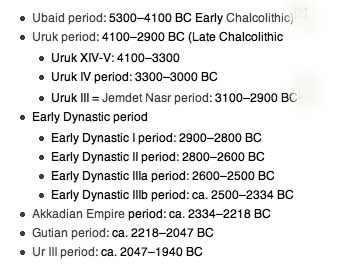
Permanent year-round urban settlement may have been prompted by intensive agricultural practices. The work required in maintaining irrigation canals called for, and the resulting surplus food enabled, relatively concentrated populations. However, this analysis, often identified with Karl Wittfogel's theories on the Asiatic mode of production, is hotly controverted, and few archaeologists or historians today accept it as a sufficient explanation for the first cities.[citation needed] The centres of Eridu and Uruk, two of the earliest cities, had successively elaborated large temple complexes built of mudbrick. Developing as small shrines with the earliest settlements, by the Early Dynastic I period, they had become the most imposing structures in their respective cities, each dedicated to its own respective god. From south to north, the principal temple-cities, their principal temple complex, and the gods they served, were
Ur, E-kishnugal, Nanna (moon)
Larsa, E-babbar, Utu (sun)
Uruk, E-anna, Inana and An
Bad-tibira, E-mush, Dumuzi and Inana
Girsu, E-ninnu, Ningirsu
Umma, E-mah, Shara (son of Inana)
Nippur, E-kur, Enlil
Shuruppak, E-dimgalanna, Sud (variant of Ninlil, wife of Enlil)
Marad, E-igikalamma, Lugal-Marada (variant of Ninurta)
Kish, Ninhursag
Sippar, E-babbar, Utu (sun)
Kutha, E-meslam, Nergal
In the possibly mythical[citation needed] pre-dynastic period, the Sumerian king list portrays the passage of power from Eridu to Shuruppak in the south, until a flood occurred, from where it relocated to the northern city of Kish at the start of the Early Dynastic period. Hegemony, which came to be conferred by the Nippur priesthood, alternated among a number of competing dynasties, hailing from Sumerian city-states traditionally including Kish, Uruk, Ur, Adab and Akshak, as well as some from outside of southern Mesopotamia, such as Awan, Hamazi, and Mari, until the Akkadians, under Sargon of Akkad, overtook the area. Archaeologists have confirmed the presence of a widespread layer of riverine silt deposits, shortly after the Piora oscillation, interrupting the sequence of settlement, that left a few feet of yellow sediment in the cities of Shuruppak and Uruk and extended as far north as Kish. The polychrome pottery characteristic of the Jemdet Nasr period (3100-2900 BC) below the sediment layer was followed by Early Dynastic I artifacts above the sediment layer.
The Early Dynastic Period began after a cultural break with the preceding Jemdet Nasr period that has been radio-carbon dated to about 2900 BC at the beginning of the Early Dynastic I Period. No inscriptions have yet been found verifying any names of kings that can be associated with the Early Dynastic I period. The ED I period is distinguished from the ED II period by the narrow cylinder seals of the ED I period and the broader wider ED II seals engraved with banquet scenes or animal-contest scenes
The Early Dynastic II period is when Gilgamesh, the famous king of Uruk, is believed to have reigned. Texts from the ED II period are not yet understood. Later inscriptions have been found bearing some Early Dynastic II names from the King List. The Early Dynastic IIIa period, also known as the Fara period, is when syllabic writing began. Accounting records and an undeciphered logographic script existed before the Fara Period, but the full flow of human speech was first recorded about 2600 BC at the beginning of the Fara Period. The Early Dynastic IIIb period is also known as the Pre-Sargonic period.
After a flood occurred in Sumer, kingship is said to have resumed at Kish. The earliest Dynastic name on the list known from other legendary sources is Etana, whom it calls "the shepherd, who ascended to heaven and consolidated all the foreign countries". He was estimated by Roux to have lived approximately 3000 BC. Among the 11 kings who followed, a number of Semitic Akkadian names are recorded, suggesting that these people made up a sizable proportion of the population of this northern city.
The earliest monarch on the list whose historical existence has been independently attested through archaeological inscription is En-me-barage-si of Kish (ca. 2700-2600 BC), said to have conquered Elam and built the temple of Enlil in Nippur. Enmebaragesi's successor, Aga, is said to have fought with Gilgamesh of Uruk, the fifth king of that city. From this time, for a period Uruk seems to have had some kind of hegemony in Sumer. This illustrates a weakness of the Sumerian kinglist, as contemporaries are often placed in successive dynasties, making reconstruction difficult.
Mesh-ki-ang-gasher is listed as the first King of Uruk. He was followed by Enmerkar. The epic Enmerkar and the Lord of Aratta tells of his voyage by river to Aratta, a mountainous, mineral-rich country up-river from Sumer. He was followed by Lugalbanda, also known from fragmentary legends, and then by Dumuzid, the Fisherman. The most famous monarch of this dynasty was Dumuzid's successor Gilgamesh, hero of the Epic of Gilgamesh, where he is called Lugalbanda's son. Ancient, fragmentary copies of this text have been discovered in locations as far apart as Hattusas in Anatolia, Megiddo in Israel, and Tell el Amarna in Egypt.
This dynasty is dated to the 26th century BC.[citation needed] Meskalamdug is the first archaeologically recorded king (Lugal from lu=man, gal=big) of the city of Ur. He was succeeded by his son Akalamdug, and Akalamdug by his son Mesh-Ane-pada. Mesh-Ane-pada is the first king of Ur listed on the king list, and it says he defeated Lugalkildu of Uruk. He also seems to have subjected Kish, thereafter assuming the title "King of Kish" for himself.
This title would be used by many kings of the preeminent dynasties for some time afterward. King Mesilim of Kish is known from inscriptions from Lagash and Adab stating that he built temples in those cities, where he seems to have held some influence. He is also mentioned in some of the earliest monuments from Lagash as arbitrating a border dispute between Lugal-sha-engur, ensi (high priest or governor) of Lagash, and the ensi of their main rival, the neighboring town of Umma. Mesilim's placement before, during, or after the reign of Mesannepada in Ur is uncertain, owing to the lack of other synchronous names in the inscriptions, and his absence from the king list.
The Awan Dynasty was the first dynasty of Elam of which anything is known today, appearing at the dawn of historical record. The Elamites were likely major rivals of neighboring Sumer from remotest antiquity; they were said to have been defeated by Enmebaragesi of Kish (ca. 25th century BC), who is the earliest archaeologically attested Sumerian king, as well as by a later monarch, Eannatum I of Lagash.
Awan was a city or possibly a region of Elam whose precise location is not certain, but it has been variously conjectured to be north of Susa, in south Luristan, close to Dezful, or Godin Tepe. According to the Sumerian king list, a dynasty from Awan exerted hegemony in Sumer at one time. It mentions three Awan kings, who supposedly reigned for a total of 356 years.
Enshakushanna was a king of Uruk in the later 3rd millennium BC who is named on the Sumerian king list, which states his reign to have been 60 years. He was succeeded in Uruk by Lugal-kinishe-dudu, but the hegemony seems to have passed to Eannatum of Lagash for a time.
Following this period, the region of Mesopotamia seems to have come under the sway of a Sumerian conqueror from Adab, Lugal-Ane-mundu, ruling over Uruk, Ur, and Lagash. According to inscriptions, he ruled from the Persian Gulf to the Mediterranean, and up to the Zagros Mountains, including Elam. However, his empire fell apart with his death. Sumerian records also show Nin-Kasalsi as the first ruler of the city of Adab. Like the later "King" of the Third Dynasty of Kish, Nin-Kasalsi was a woman.
Lugal-Ane-mundu's power may have been limited, however, as his reign seems to have been contemporaneous with the Third Dynasty of Kish, inaugurated by Kug-Bau or Kubaba, unique in the fact that she was the only woman ever to reign as "king". Before overthrowing the rule of Enshakushana of the Second Uruk Dynasty and becoming monarch, the king-list says she was a tavern-keeper. In later centuries she was worshipped as a minor goddess, achieving important status in the Hurrian and Hittites periods, when she was identified with the Hurrian goddess Hannahannah[citation needed]. In the post-Hittite Phrygian period she was called Kubele (Latin Cybele), Great Mother of the Gods.
Akshak too achieved independence with a line of rulers extending from Puzur-Nirah, Ishu-Il, and Shu-Suen, son of Ishu-Il, before being defeated by the rulers in the Fourth Dynasty of Kish.
Akshak was a city of ancient Sumer, situated on the northern boundary of Akkad, sometimes identified with Babylonian Upi (Greek Opis). Its exact location is uncertain. Classical writers located it where the Tigris and Euphrates rivers are closest together and it was mentioned along with Kish in early records. Archaeologists in the 1900s placed Akshak at the site of Tel Omar (or Tel Umar) where a pair of sites straddles the Tigris, but that turned out to be Seleucia (possibly earlier Upi/Opis) when it was excavated by LeRoy Waterman of the American Schools of Oriental Research. Michael C. Astour placed it on the Tigris, on what is now the southern outskirts of Baghdad.
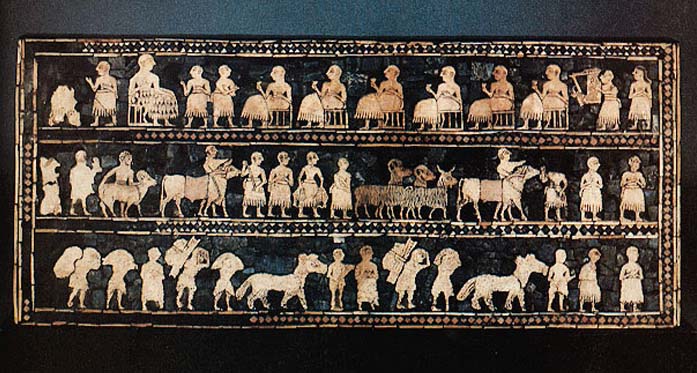
This dynasty is dated to the 25th century BC. En-hegal is recorded as the first known ruler of Lagash, being tributary to Uruk. His successor Lugal-sha-engur was similarly tributary to Mesilim. Following the hegemony of Mesannepada of Ur, Ur-Nanshe succeeded Lugal-sha-engur as the new high priest of Lagash and achieved independence, making himself king. He defeated Ur and captured the king of Umma, Pabilgaltuk. In the ruins of a building attached by him to the temple of Ningirsu, terracotta bas reliefs of the king and his sons have been found, as well as onyx plates and lions' heads in onyx reminiscent of Egyptian work. One inscription states that ships of Dilmun (Bahrain) brought him wood as tribute from foreign lands. He was succeeded by his son Akurgal.
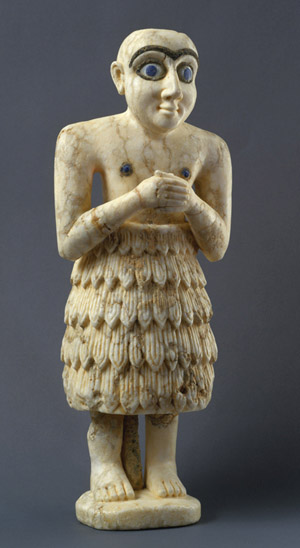
Eannatum, grandson of Ur-Nanshe, made himself master of the whole of the district of Sumer, together with the cities of Uruk (ruled by Enshakushana), Ur, Nippur, Akshak, and Larsa. He also annexed the kingdom of Kish; however, it recovered its independence after his death. Umma was made tributary - a certain amount of grain being levied upon each person in it, that had to be paid into the treasury of the goddess Nina and the god Ningirsu.
Eannatum's campaigns extended beyond the confines of Sumer, and he overran a part of Elam, took the city of Az on the Persian Gulf, and exacted tribute as far as Mari; however many of the realms he conquered were often in revolt. During his reign, temples and palaces were repaired or erected at Lagash and elsewhere; the town of Nina - that probably gave its name to the later Niniveh - was rebuilt, and canals and reservoirs were excavated. Eannatum was succeeded by his brother, En-anna-tum I. During his rule, Umma once more asserted independence under Ur-Lumma, who attacked Lagash unsuccessfully. Ur-Lumma was replaced by a priest-king, Illi, who also attacked Lagash.
His son and successor Entemena restored the prestige of Lagash. Illi of Umma was subdued, with the help of his ally Lugal-kinishe-dudu or Lugal-ure of Uruk, successor to Enshakushana and also on the king-list. Lugal-kinishe-dudu seems to have been the prominent figure at the time, since he also claimed to rule Kish and Ur. A silver vase dedicated by Entemena to his god is now in the Louvre.
A frieze of lions devouring ibexes and deer, incised with great artistic skill, runs round the neck, while the eagle crest of Lagash adorns the globular part. The vase is a proof of the high degree of excellence to which the goldsmith's art had already attained. A vase of calcite, also dedicated by Entemena, has been found at Nippur. After Entemena, a series of weak, corrupt priest-kings is attested for Lagash. The last of these, Urukagina, was known for his judicial, social, and economic reforms, and his may well be the first legal code known to have existed.
Urukagina ( ca. 2359Ð2335 BC short chronology) was overthrown and his city Lagash captured by Lugal-zage-si, the high priest of Umma. Lugal-zage-si also took Uruk and Ur, and made Uruk his capital. In a long inscription that he made engraved on hundreds of stone vases dedicated to Enlil of Nippur, he boasts that his kingdom extended "from the Lower Sea (Persian Gulf), along the Tigris and Euphrates, to the Upper Sea" or Mediterranean. His empire was overthrown by Sargon of Akkad.
The Akkadian period lasted ca. 2334Ð2218 BC (short chronology).
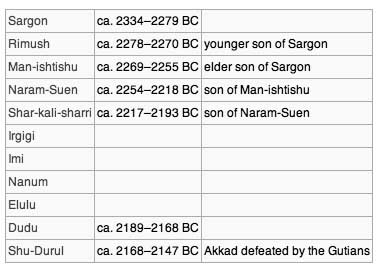
The Gutian dynasty came to power in Mesopotamia around 2150 BC (short chronology), by destabilising Akkad, according to the Sumerian kinglist at the end of the reign of king Ur-Utu (or Lugal-melem) of Uruk. They reigned for perhaps around one century (copies of the kinglist vary between 25 and 124 years; 91 years is often quoted as probable). The dynasty was succeeded by the 3rd dynasty of Ur. The Gutian people (Guti) were native to Gutium, presumably in the central Zagros Mountains; almost nothing is known about their origins.
The Gutians practiced hit-and-run tactics, and would be long gone by the time regular troops could arrive to deal with the situation. Their raids crippled the economy of Sumer. Travel became unsafe, as did work in the fields, resulting in famine.
The Sumerian king list indicates that king Ur-Utu of Uruk was defeated by the barbarian Guti, perhaps around 2150 BC. The Guti swept down, defeated the demoralized Akkadian army, took Akkad, and destroyed it around 2115 BC. However, they did not supplant all of Akkad, as several independent city states remained alongside them, including Lagash, where a local dynasty still thrived and left numerous textual and archaeological remains.
Ultimately Akkad was so thoroughly destroyed that its site is still not known. The Guti proved to be poor rulers. Under their crude rule, prosperity declined. They were too unaccustomed to the complexities of civilization to organize matters properly, particularly in connection with the canal network. This was allowed to sink into disrepair, with famine and death resulting. Thus, a short "dark age" swept over Mesopotamia.
Akkad bore the brunt of this as the center of the Empire, so that it was in Akkad that the Guti established their own center in place of the destroyed Akkad. Some of the Sumerian cities in the south took advantage of the distance and purchased a certain amount of self-government by paying tribute to the new rulers.
Uruk was thus able to develop a 5th dynasty. Even in the city of Akkad itself, a local dynasty was said to have ruled. The best known Sumerian ruler of the Gutian period was the ensi of Lagash, Gudea. Under him, ca. 2075 BC (short), Lagash had a golden age.
After a few kings, the Gutian rulers became more cultured. Guti rule lasted only about a century - around 2050 BC, they were expelled from Mesopotamia by the rulers of Uruk and Ur, when Utu-hengal of Uruk defeated Gutian king Tirigan. Utu-hengal's victory revived the political and economic life of southern Sumer.

Lagashmodern Tell al-Hiba, Dhi Qar Governorate, Iraq) is located northwest of the junction of the Euphrates and Tigris rivers and east of Uruk, about 22 kilometres (14 mi) east of the modern town of Ash Shatrah. Lagash was one of the oldest cities of the Ancient Near East. The ancient site of Surghul/Nina is around 6 miles (9.7 km) away. Nearby Girsu, about 25 km (16 mi) northwest of Al-Hiba, was the religious center of the Lagash state. Lagash's temple was E-Ninnu, dedicated to the god Ningirsu.
From inscriptions found at Girsu such as the Gudea cylinders, it appears that Lagash was an important Sumerian city in the late 3rd millennium BC. It was at that time ruled by independent kings, Ur-Nanshe (24th century BC) and his successors, who were engaged in contests with the Elamites on the east and the kings of "Kiengir and Kish on the north. Some of the earlier works from before the Akkadian conquest are also extremely interesting, in particular Eannatum's Stele of the Vultures and Entemena's great silver vase ornamented with Ningirsu's sacred animal Anzu: a lion-headed eagle with wings outspread, grasping a lion in each talon. With the Akkadian conquest Lagash lost its independence, its ruler or ensi becoming a vassal of Sargon of Akkad and his successors; but Lagash continued to be a city of much importance and above all, a centre of artistic development.
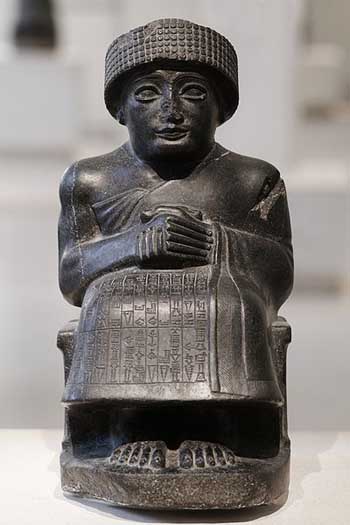
After the collapse of Sargon's state, Lagash again thrived under its independent kings (ensis), Ur-Bau and Gudea, and had extensive commercial communications with distant realms. According to his own records, Gudea brought cedars from the Amanus and Lebanon mountains in Syria, diorite from eastern Arabia, copper and gold from central and southern Arabia, while his armies were engaged in battles with Elam on the east.
His was especially the era of artistic development. We even have a fairly good idea of what Gudea looked like, since he placed in temples throughout his city numerous statues or idols depicting himself with lifelike realism, (Statues of Gudea). At the time of Gudea, the capital of Lagash was actually in Girsu. The kingdom covered an area of approximately 1,600 square kilometres (620 sq mi). It contained 17 larger cities, eight district capitals, and numerous villages (about 40 known by name). According to one estimate, Lagash was the largest city in the world from ca. 2075 to 2030 BC.
Soon after the time of Gudea, Lagash was absorbed into the Ur III state as one of its prime provinces. There is some information about the area during the Old Babylonian period. After that it seems to have lost its importance; at least we know nothing more about it until the construction of the Seleucid fortress mentioned, when it seems to have become part of the Greek kingdom of Characene.
These dynasties are not found on the Sumerian King List, although one extremely fragmentary supplement has been found in Sumerian, known as the rulers of Lagash. It recounts how after the flood mankind was having difficulty growing food for itself, being dependent solely on rainwater; it further relates that techniques of irrigation and cultivation of barley were then imparted by the gods. At the end of the list is the statement "Written in the school", suggesting this was a scribal school production. A few of the names from the Lagash rulers listed below may be made out, including Ur-Nanshe, "Ane-tum", En-entar-zid, Ur-Ningirsu, Ur-Bau, and Gudea.

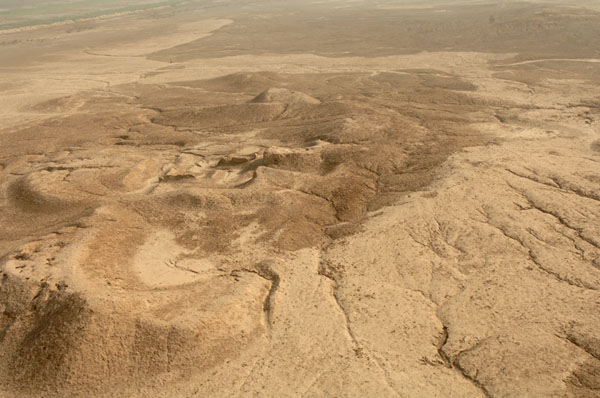
Lagash is one of the largest archaeological mounds in the region, measuring roughly 2 by 1 miles (3.2 by 1.6 km). Estimates of its area range from 400 to 600 hectares (990 to 1,500 acres). The site is divided by the bed of a canal/river, which runs diagonally through the mound. The site was first excavated, for six weeks, by Robert Koldewey in 1887. It was inspected during a survey of the area by Thorkild Jacobsen and Fuad Safar in 1953, finding the first evidence of its identification as Lagash. The major polity in the region of al-Hiba and Tello had formerly been identified as SIR.BUR.LA (Shirpurla).
Tell Al-Hiba was again explored in five seasons of excavation between 1968 and 1976 by a team from the Metropolitan Museum of Art and the Institute of Fine Arts of New York University. The team was led by Vaughn E. Crawford, and included Donald P. Hansen and Robert D. Biggs. The primary focus was the excavation of the temple Ibgal of Inanna and the temple Bagara of Ningirsu, as well as an associated administrative area.
The team returned 12 years later in 1990 for a final season of excavation led by D. P. Hansen. The work primarily involved areas adjacent to an as yet unexcavated temple. The results of this season have apparently not yet been published.
This dynasty lasted between ca. 2055Ð2048 BC short chronology. The Gutians were ultimately driven out by the Sumerians under Utu-hegal, the only king of this dynasty, who in turn was defeated by Ur-Nammu of Ur.
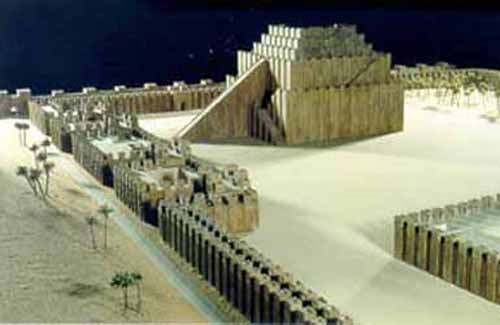
Ur
The Third Dynasty of Ur is dated to ca. 2047-1940 BC short chronology. Ur-Nammu of Ur defeated Utu-hegal of Uruk and founded the Third Dynasty of Ur. Although the Sumerian language ("Emegir") was again made official, Sumerian identity was already in decline, as the population became continually more and more Semiticized.
After the Ur III dynasty was destroyed by the Elamites in 2004 BC, a fierce rivalry developed between the city-states of Larsa, more under Elamite than Sumerian influence, and Isin, that was more Amorite (as the Western Semitic nomads were called). Archaeologically, the fall of the Ur III dynasty corresponds to the beginning of the Middle Bronze Age. The Semites ended up prevailing in Mesopotamia by the time of Hammurabi of Babylon, who founded the Babylonian Empire, and the language and name of Sumer gradually passed into the realm of antiquarian scholars. Nevertheless, Sumerian influence on Babylonia, and all subsequent cultures in the region, was undeniably great.
During the third millennium BC, there developed a very intimate cultural symbiosis between the Sumerians and the Akkadians, which included widespread bilingualism. The influence of Sumerian on Akkadian (and vice versa) is evident in all areas, from lexical borrowing on a massive scale, to syntactic, morphological, and phonological convergence.
This has prompted scholars to refer to Sumerian and Akkadian in the third millennium as a Sprachbund - also known as a linguistic area, convergence area, diffusion area or language crossroads - is a group of languages that have become similar in some way because of geographical proximity and language contact. They may be genetically unrelated, or only distantly related. Where genetic affiliations are unclear, the Sprachbund characteristics might give a false appearance of relatedness. Areal features are common features of a group of languages in a Sprachbund.
Akkadian gradually replaced Sumerian as the spoken language of Mesopotamia somewhere around the turn of the third and the second millennium BC (the exact dating being a matter of debate), but Sumerian continued to be used as a sacred, ceremonial, literary and scientific language in Mesopotamia until the first century AD. History of Sumer